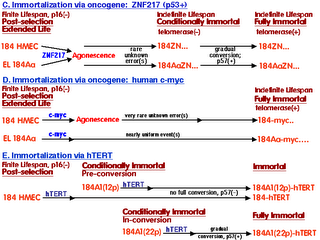DNA Repair: BRIT1 in Cancer--Built-In Telomerase Inhibitor Blocks Cell Immortalisation
 BRIT1 is a gene that functions as a transcriptional inhibitor of hTERT (human telomerase reverse transcriptase), the catalytic subunit of human telomerase. hTERT is the rate limiting determinant of telomerase and cell immortalisation.
BRIT1 is a gene that functions as a transcriptional inhibitor of hTERT (human telomerase reverse transcriptase), the catalytic subunit of human telomerase. hTERT is the rate limiting determinant of telomerase and cell immortalisation.This Newswise newsrelease discusses recent developments in uncovering the relationship between BRIT1, hTERT, DNA repair, and cancer onset.
A single gene plays a pivotal role launching two DNA damage detection and repair pathways in the human genome, suggesting that it functions as a previously unidentified tumor suppressor gene, researchers at The University of Texas M. D. Anderson Cancer Center report in Cancer Cell.Source.
The advance online publication also reports that the gene - called BRIT1 - is under-expressed in human ovarian, breast and prostate cancer cell lines.
Defects in BRIT1 seem to be a key pathological alteration in cancer initiation and progression, the authors note, and further understanding of its function may contribute to novel, therapeutic approaches to cancer.
"Disruption of BRIT1 function abolishes DNA damage responses and leads to genomic instability," said senior author Shiaw-Yih Lin, Ph.D., assistant professor in the Department of Molecular Therapeutics at M. D. Anderson. Genomic instability fuels the initiation, growth and spread of cancer.
A signaling network of molecular checkpoint pathways protects the human genome by detecting DNA damage, initiating repair and halting division of the damaged cell so that it does not replicate.
In a series of laboratory experiments, Lin and colleagues show that BRIT1 activates two of these checkpoint pathways. The ATM pathway springs into action in response to damage caused by ionizing radiation. The ATR pathway responds to DNA damage caused by ultraviolet radiation.
By using small interfering RNA (siRNA) to silence the BRIT1 gene, the scientists shut down both checkpoint pathways in cells exposed to either type of radiation.
Researchers then used siRNA to silence the gene in normal human mammary epithelial cells (HMEC). The result: Inactivation of the gene caused chromosomal aberrations in 21.2 to 25.6 percent of cells. Control group HMEC had no cells with chromosomal aberrations. In cells with the gene silenced that were then exposed to ionizing radiation, 80 percent of cells had chromosomal aberrations.
"We also found that BRIT1 expression is aberrant in several forms of human cancer," Lin said. The team found reduced expression of the gene in 35 of 87 cases of advanced epithelial ovarian cancer. They also found reduced expression in breast and prostate cancer tissue compared with non-cancerous cells.
Genetic analysis of breast cancer specimens revealed a truncated, dysfunctional version of the BRIT1 protein in one sample.
Loss of the DNA damage checkpoint function and the ability to proliferate indefinitely are two cellular changes required for the development of cancer. Lin and colleagues have now tied the gene to both factors. They previously identified BRIT1 as a repressor of hTERT, a protein that when reactivated immortalizes cells, allowing them to multiply indefinitely.
The cell signaling pathways that regulate detection of DNA damage and the subsequent halting of the cell cycle, DNA repair, and possibly trigger apoptosis, is very complex. By using tools such as siRNA to selectively block individual components of this complex network, researchers can get closer to understanding how this intricate cell machinery functions.
The relationship between BRIT1, hTERT, cancer and cell immortalisation, suggests tantalising clues to possible cancer treatments as well as anti-aging therapies. But it is still too early to be certain of the best avenue of approach. This is an intriguing line of research, nevertheless.
Labels: cell signalling, DNA repair

0 Comments:
Post a Comment
“During times of universal deceit, telling the truth becomes a revolutionary act” _George Orwell
<< Home